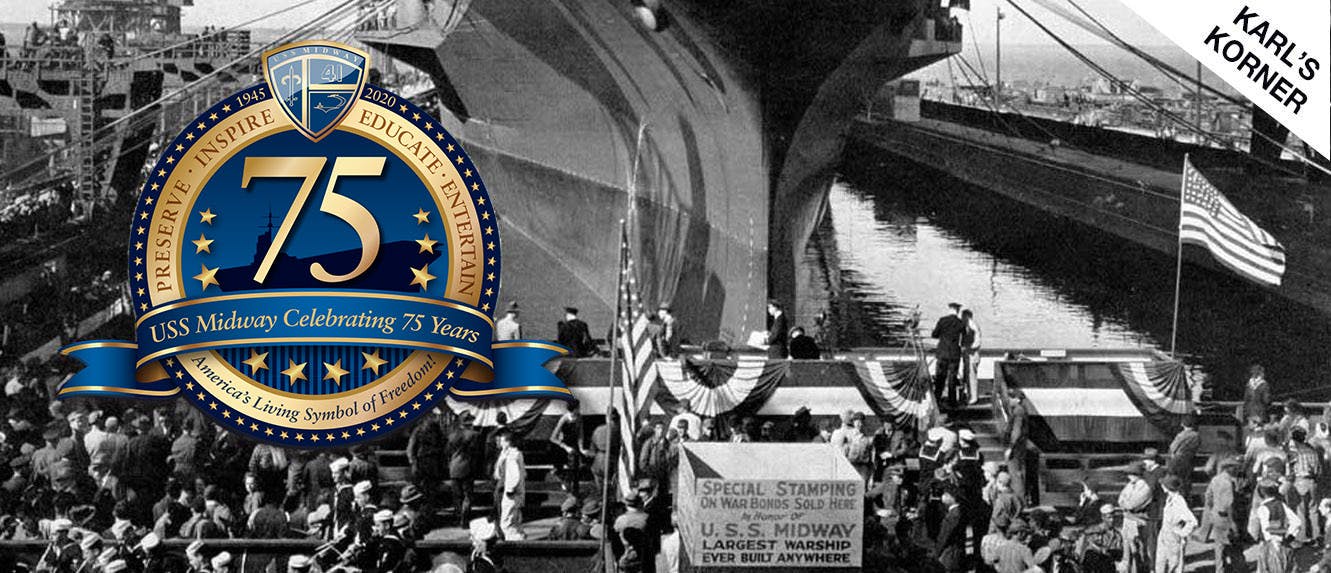 October 11, 2016 | Karl’s Korner
October 11, 2016 | Karl’s KornerBuilding the USS Midway: Part 2
Welcome back to Karl’s Korner! As promised, I want to finish off how the USS Midway was built, Part 2. If you haven’t read Part 1, click here. Thank you again for joining me, Midway’s Ship Historian as I look back!
Part 2
With some 70 tons of blueprints completed, detailed analysis of the armor on the Illustrious, and hard lessons from the loss of carriers in the Pacific, naval planners called for the construction of four new large carriers, designated “CVB” for fiscal year 1943. However, President Roosevelt opted not to include these ships while otherwise approving the rest of the spending plan in August 1942. He was concerned about tying up resources for a few very large ships instead of devoting them to the delivery of several smaller vessels sooner. However, after consultation with naval officials in Washington, he approved the construction of just two CVB’s before year’s end.
Accordingly, on 27 October 1943, the keel for CVB-41 was laid in Shipway 11 at the Newport News Shipbuilding Yard in Virginia. Despite the pressing needs of other wartime projects, and the newness of the CVB design, work progressed with astonishing speed. This was largely the result of extensive welding in place of traditional riveted construction. With a waterline length of 900 feet, the new carrier was already longer than other carriers serving, and with no compunction about tonnage limits, the hull layout indulgently provided separate rooms for each of its four engines, twelve boilers, and auxiliary machinery. Although the engineering plant was especially damage-resistant, it also made getting about below decks difficult, as there were no lateral passages between these rooms. By January 1945, with the Battle of the Bulge winding down, work had advanced to the hangar deck, with 2 inches of armor running most of its length. As Nazi Germany was invaded, and ferocious combat raged on Iwo Jima, construction proceeded up to the capacious flight deck, sporting 3.5 inches of armor. Even the island superstructure took on the hallmarks usually seen in an armored capital ship—a protected conning tower running up through the interior of the navigation bridge. Trouble was, even on battleships and cruisers, such a structure was unpopular with captains, and on a small carrier bridge, it was beyond awkward. A year into service, the entire forward bridge structure was replaced.
On 20 March 1945 the CVB-41 was christened “Midway” by Barbara Cox Ripley, and the building dock was flooded, floating the massive hull into Hampton Roads. A remarkable feature appearing as the Midway lay along the fitting out dock was the heaviest gun armament seen since the 8-inch gun mounts on the old Lexington and Saratoga. No fewer than 18 new 5-inch guns of the longer 54-calibre design, also intended for the never-built Montana class super battleships, lined the sides of the hangar decks, as well as a generous suite of lighter automatic anti-aircraft guns. Although the shipyard dedicated three shifts every day of the week, the complex new carrier was not quite completed when Japan capitulated in August 1945. On 11 September, just nine days after the surrender ceremony on the deck of the USS Missouri, the new USS Midway was commissioned into active service. Visitors marveled at the large scale of the new carrier, particularly the 924-foot long flight deck, able to operate an unheard of 120 combat aircraft. For the next ten years, the Midway and her two sisters would be the largest warships in the world. After bringing aboard the last of her new crew of 3,443, Captain Joseph Bolger took the Midway out to sea on 12 October 1945, embarking on an adventure that continues to this day.
Launch em’... until next time,
Karl
Your Adventure Starts Now
Your email is the key to information that will open up all your possibilities for exploring the mighty Midway!

